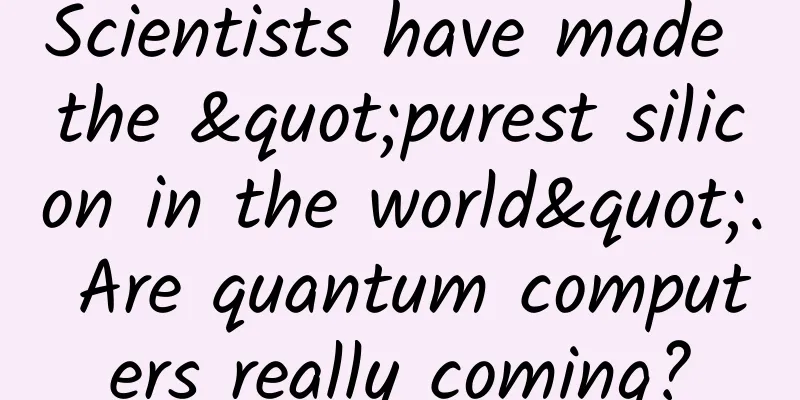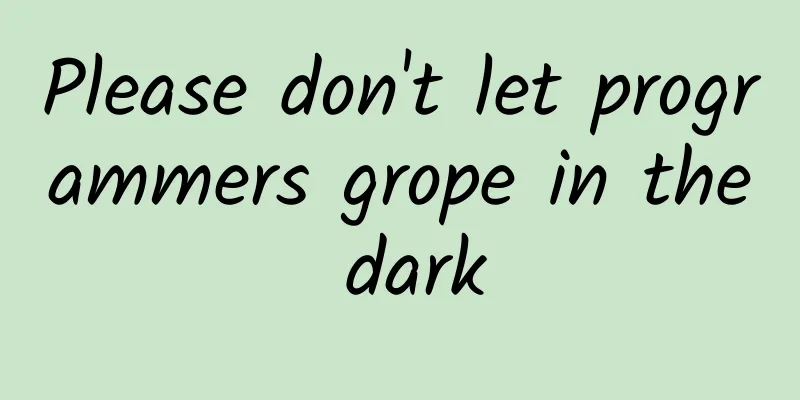Scientists have made the "purest silicon in the world". Are quantum computers really coming?

|
On May 7, 2024, researchers from the University of Manchester in the UK and the University of Melbourne in Australia published a breakthrough study in the journal Nature Communications Materials. They used focused ion beam (FIB) technology to create a highly enriched 28Si "ultra-pure silicon". This discovery provides a new way to build high-performance quantum bit devices with scalable quantum computers, thus laying the foundation for a stable quantum computing platform. (Source: Screenshot of Nature Communications Materials official website) Although research results in the field of quantum computing are often obscure and difficult to understand, quantum computers and the concepts of quantum appear frequently in life (for example, the famous meme: quantum mechanics is used when in doubt). So, what exactly is quantum computing? Is it really possible to realize quantum computers? Is it possible to try to understand them using concepts in real life? In order to give you a preliminary understanding of quantum computing, we will try to talk to you about the three or five things about quantum computing in popular and concrete language as much as possible. What problems do quantum computers solve? Unlike classical computing, quantum computing follows the laws of quantum mechanics. It is a new computing model that can break through the bottleneck of classical computing power. Quantum computers use quantum bits as the basic computing unit . The so-called quantum bits are distinguished from classical bits. The development of quantum computing (Source: IBM) The above sentences may seem difficult to understand, so let’s break them down sentence by sentence. Quantum computing, seeing this term with the word "quantum" in its title, it is hard not to associate it with quantum mechanics. Naturally, this computing method based on the principles of quantum mechanics is fundamentally different from traditional classical computing. Specifically, in classical computing, information is represented by binary digits (bits), which are either 0 or 1, similar to a "switch" with only two states: on and off. However, quantum computing breaks this tradition, and information is represented by another way, namely quantum bits (qubits), which can be in the state of 0 and 1 at the same time, that is, a superposition state (here you can refer to Mr. Schrödinger's magical cat that is both dead and alive). In addition, there can be a special connection between quantum bits, called quantum entanglement , which is more like a "switch knob" that can be in multiple states. With their unique properties, quantum computers are able to use quantum bits for calculations, and their computing power can achieve an exponential explosion (this is because r quantum bits can carry a superposition of 2r states, thereby achieving 2r times the amount of computing power in each calculation. In contrast, a classical computer requires 2r classical bits to achieve the same computing power). Therefore, qubits are better at calculating certain specific mathematical problems, which means that quantum computers can transcend and reshape various fields, breaking through the limits that currently hinder anything involving quantum mechanics. Are quantum computers possible? To realize quantum computing, the current mainstream technology routes include superconductivity, ion traps, semiconductors, optics, quantum topology, etc. (Among them, superconductivity and ion traps are developing the fastest). At present, each technology route has its advantages and disadvantages, and no route can fully meet the requirements of practical application. The main technical routes for realizing quantum computing (Source: "2023 Global Quantum Computing Industry Development Outlook") Quantum computers use quantum ratios to replace binary bits in traditional computers, achieving a leap in computing power through quantum superposition and quantum entanglement. The concept of quantum computers can be traced back to the 1980s, when American physicist Richard Feynman proposed the idea of using quantum systems to simulate other quantum systems. In 1994, American computer scientist Peter Shor proposed a quantum algorithm that can efficiently factorize large numbers, demonstrating the potential advantages of quantum computers in solving specific problems. The development history of quantum computers (Source: Nikkei Chinese website) Since the beginning of the 21st century, the development of quantum computers has become one of the major challenges at the forefront of global science and technology. Internationally renowned technology companies such as IBM, Google, Intel, and many universities have invested a lot of resources in the field of quantum computing. In 2019, Google developed a 53-qubit computer called "Linden", which achieved quantum supremacy for the first time in the world. They claimed to have achieved "quantum hegemony" (the performance of quantum processors on specific tasks exceeded that of the most advanced classical supercomputers at the time). It is worth noting that China has also made significant progress in the field of quantum computing. In 2020, the team of Academician Pan Jianwei of the University of Science and Technology of China built a 76-photon quantum computing prototype "Jiuzhang", making China the second country in the world to achieve quantum supremacy. In 2021, the team of Academician Pan Jianwei and his collaborators successfully developed the 113-photon "Jiuzhang-2" and the 66-bit "Zu Chongzhi-2" quantum computing prototypes, making China the country to achieve quantum supremacy in both optical and superconducting technology routes. In 2023, the team of Academician Pan Jianwei and his collaborators successfully built a 255-photon quantum computer prototype "Jiuzhang-3", which is 100 trillion times faster than the world's fastest supercomputer and 1 million times faster than "Jiuzhang-2" when solving specific mathematical problems. It can be said that China has taken an international leading position in the field of quantum computing. What exactly is “ultra-pure silicon”? Silicon is a common semiconductor material that is widely used in modern electronic technology. Silicon-based quantum computing is an important branch of the field of quantum computing, which uses the properties of silicon materials to achieve the storage and operation of quantum bits. Specifically, in silicon-based quantum computing, electrons in silicon can be confined to tiny areas to form so-called quantum dots. These quantum dots can be used as quantum bits to store and process quantum information. Silicon-based quantum computing has many potential advantages, including compatibility with existing semiconductor processes (meaning that most of its processes are compatible with traditional semiconductor processes and are easy to connect with the semiconductor industry), longer coherence time (referring to the time that quantum bits retain their quantum properties) and scalability (increasing the number of quantum bits to achieve large-scale quantum computing), which makes them more suitable for quantum computing. Silicon quantum computing appears on the cover of Nature. Image source: Nature magazine Both classical computing and quantum computing require high-purity silicon with a regular crystal structure. This is because amorphous silicon is full of dangling bonds, oxygen molecules and other impurities, resulting in poor electrical properties. However, there is a problem that cannot be ignored when silicon is directly extracted from nature, that is, it contains three stable isotopes: silicon-28 (28Si), silicon-29 (29Si) and silicon-30 (30Si). Among them, silicon-29 accounts for about 4.68% of silicon, and its atomic nucleus carries a non-zero nuclear spin, which will interfere with the electron spin used to encode quantum bits through dipole interactions. Silicon-30 only accounts for 3.09% of silicon, with a small content and a large interaction between the electron spin and the nuclear spin. This makes only silicon-28 considered to be a relatively ideal and pure quantum computing material. Therefore, minimizing the impact of silicon-29 and silicon-30 is the key to improving quantum computing performance. To solve this problem, the research team used focused ion beam technology to shoot a focused and high-speed beam of pure silicon-28 ions at the silicon wafer from a focused ion beam system called P-NAME. By implanting silicon-28, the silicon-29 in natural silicon was consumed, thereby reducing the proportion of silicon-29 from 4.68% to a maximum of 0.00023% (2.3ppm), and the proportion of -30 from 3.09% to a maximum of 0.00006% (0.6ppm). They then recrystallized the implanted amorphous state through a two-step annealing process, restoring the crystalline structure of the silicon wafer. This technique not only enables this extreme silicon-28 enrichment, but also avoids introducing other impurities that could interfere with the qubits. Schematic diagram of focused ion beam isotope enrichment of Si-28 (Source: Nature Communications Materials) To verify the implantation effect, the researchers used nanoscale secondary ion mass spectrometry (NanoSIMS) analysis (a technique that can accurately measure the ratio of different isotopes in a sample). Through analysis, the researchers confirmed that the residual concentration of silicon-29 in the implanted area was significantly reduced, and no additional impurities such as carbon (C) and oxygen (O) were introduced. In addition, transmission electron microscopy (TEM) analysis further confirmed the amorphous nature of the implanted volume and the epitaxial recrystallization of the single crystal phase after annealing. These results show that high-purity silicon-28-enriched regions can be achieved in silicon wafers through focused ion beam technology, which provides a guarantee for the stability of quantum bits. The "ultra-pure silicon" manufactured by this technology is expected to bring revolutionary changes to the entire society in the fields of new material design, artificial intelligence, energy storage, logistics manufacturing, etc. Professor David Jamieson (David Jamieson) of the University of Melbourne, the co-supervisor of the project, said that their next step will be to prove that this material can maintain the quantum coherence of many quantum bits at the same time. This outstanding work not only demonstrates the scientific community's progress in the preparation of quantum materials, but also paves the way for the practical application and scale-up of quantum computing. With the continuous development of quantum technology, we have reason to believe that quantum computers will completely change our world in the next few decades. References [1] Quantum computing Source: Baidu Encyclopedia, "Science Popularization China" scientific encyclopedia entry writing and application work project [2] Google published a paper claiming to have achieved "quantum supremacy"! 200 seconds of calculation is equivalent to 10,000 years of calculation by the most powerful supercomputer Source: WeChat public account FX168, Hexun.com [3] Academician Yao Qizhi: What is the difference between the mysterious quantum computing and classical computing? Source: Sina Technology's "Science Masters" column [4] USTC has realized the “Jiuzhang-3” optical quantum computing prototype Source: China University of Science and Technology News [5] Silicon quantum computer fidelity has achieved a major breakthrough, reaching over 99% Source: The Paper [6]Highly 28Si enriched silicon by localized focused ion beam implantation Source: Nature Communications Materials official website Planning and production Produced by Science Popularization China Author: Wu Junjie, PhD in Materials Physics and Chemistry Producer丨China Science Expo Editor: Yang Yaping Proofread by Xu Lai and Lin Lin |
Recommend
Is there an end to Alibaba’s traffic auction model?
Countless people admire the rise of this business...
Spending tens of thousands of dollars to bring an observation of fan circle marketing activities
With the continued popularity of many "star-...
How to speed up deep learning on mobile apps? You will know after reading this article
Currently, mobile applications that use deep lear...
Remember the harm, adapt to the harm, resist the harm: how to survive in extreme environments
Humanity has lost a lot in the three-year pandemi...
15 essential data analysis methods for operations! !
When it comes to data analysis , people often thi...
Taking Xiaohongshu as an example, let’s talk about data analysis!
Xiaohongshu has become one of the fastest growing...
Engineer sentenced for reporting environmental problems in hometown (attached with original text)
Engineer responds to being sentenced for reportin...
iPhone 12 is coming, how can designers adapt it in advance?
On October 13, Apple held its annual press confer...
If you want to create the popular animation effects, you must understand some physics
[[150479]] We will map our understanding of the w...
Recommendations for investment in major industries during the epidemic, for reference!
The novel coronavirus epidemic that has swept acr...
How to play with free channels - bringing in 300,000 users in three months
When a new APP product enters the market, how to ...
SEO snapshot, analysis of several common Baidu snapshot situations!
Snapshot is an indicator for us to measure the op...
How do we measure the age of stars and planets?
Astronomers used the Hubble Telescope to take the...









